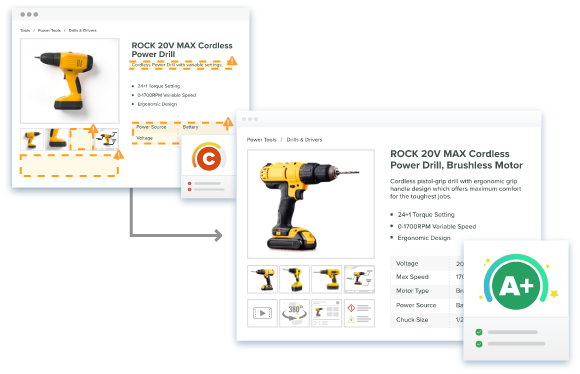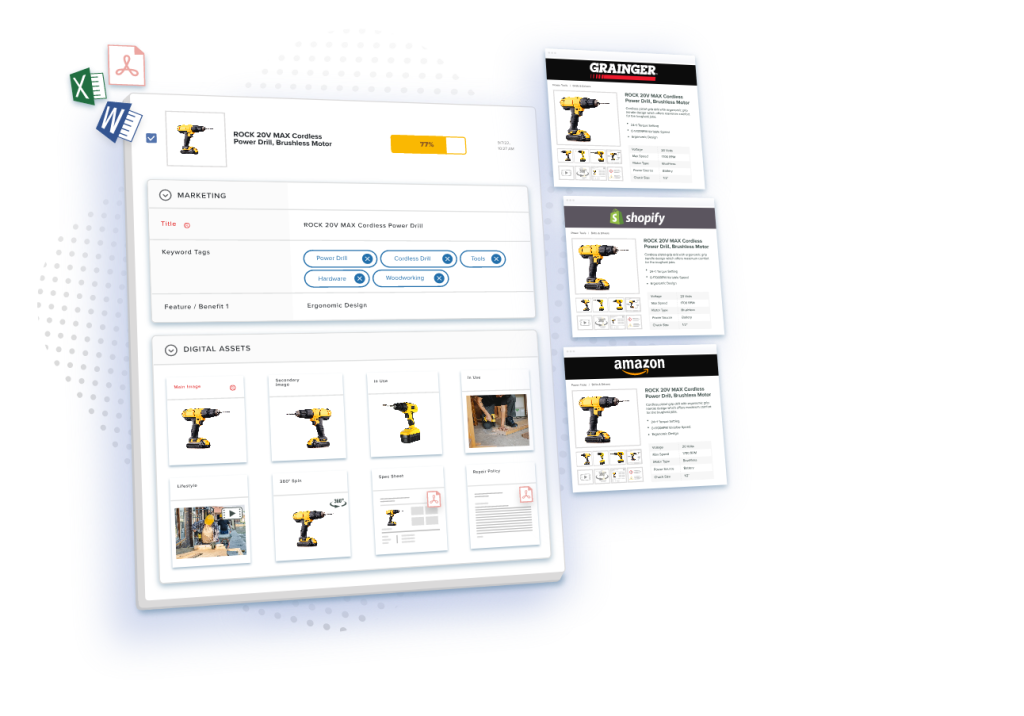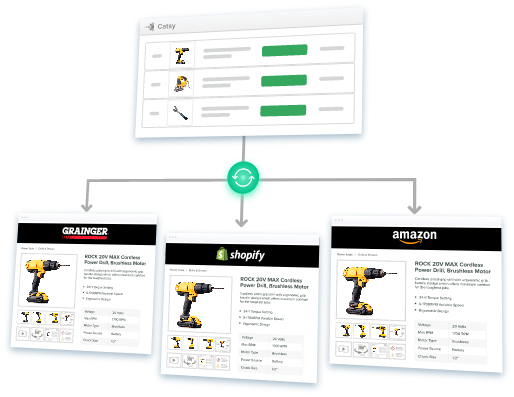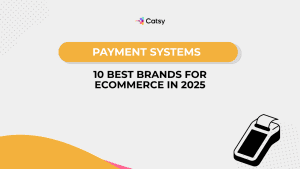Product Information Management: Debunking the Top Myths for Industrial Brands

- PIM software centralizes and manages product data to power omnichannel sales and marketing.
- Despite the clear benefits, some industrial brands hesitate to adopt PIM due to misconceptions about feasibility and return on investment.
- PIM delivers value for companies of any size looking to transform how they manage product content.
In this Article
Product information is the lifeblood of all industrial brands. However, managing extensive catalogs across fragmented systems leads to inefficient operations and poor data quality. If these problems sound familiar, you may be considering product information management (PIM) software to consolidate your product content workflow.
But, doubts or misconceptions about implementing new technology could be holding you back from moving forward with PIM. You may worry it takes too much time, doesn’t provide enough ROI, or isn’t applicable beyond large enterprises. This article tackles those myths head-on to showcase why PIM delivers tremendous value.
We’ll explore the realities around PIM implementation timelines, use cases for companies of any size, required skills, costs versus quantifiable savings, and how it supersedes makeshift platforms.

What is PIM and Why Do You Need It?
A product information management (PIM) system is a tool that centralizes the storage, management, and syndication of a company’s product data. It becomes the single source of truth for product information across all sales and marketing channels, both internal and external.
The key benefits of a PIM include:
- Increased efficiency – The tool eliminates duplicative data entry by providing a single source of truth for product information. This saves teams significant time that can be reallocated to more strategic initiatives.
- Improved data quality – With a centralized repository, PIM eliminates inconsistencies and allows you to keep information up-to-date and accurate across all channels.
- Omnichannel distribution – PIM makes it easy to syndicate enriched product content to all channels like web stores, marketplaces, print catalogs, etc.
- Scalability and agility – As your product catalog grows over time, PIM makes managing thousands of products and their associated information easy. Also, adding new products, markets, integrations, and channels is simple with a flexible PIM platform.
While the benefits are clear, some brands hesitate to implement PIM technology due to misconceptions about complexity, resources required, or use cases. This article will tackle those myths and make the case that PIM is essential for brands of any size looking to improve operations, ensure data integrity, and deliver exceptional customer experiences.

Debunking the Top Myths for Industrial Brands
Myth 1: PIM implementation takes too long.
Any new technology has a learning curve. If it takes longer for teams to get comfortable with the tool, this could lengthen the implementation time to an untenable period. Thinking that teams may need a long time to learn a PIM solution, some marketers succumb to the misconception that implementing the technology requires too much time.
The belief can’t be further from the truth, especially considering it is anchored on a misleading premise. The premise goes: since PIM is a complex and technical undertaking, it can take many months to get the system up and running.
The reality with most PIM solutions is quite the opposite. The term “most” is used because, as you may know, there are two main types of PIM: SaaS and open-source. Here is a quick overview of the differences between the two:
Aspect | SaaS PIM | Open-Source PIM |
Deployment and Accessibility | Cloud-based, accessed through a web browser. | Installed on-premises or on user-chosen cloud infrastructure. Users have control over deployment. |
Customization and Flexibility | Limited customization; relies on the provider’s features and updates. | High level of customization; users can modify the source code, providing extensive flexibility. |
Cost Structure | Subscription-based pricing model with recurring fees. | Free to use, but hosting, maintenance, and support costs may apply. Businesses have more control over costs. |
Community and Support | The SaaS provider provides customer support. | Relies on community forums, developer communities, and documentation. Premium support services may be available. |
It’s clear from the comparison that Software-as-a-Service (SaaS) PIM is the tool on which we’re focusing. For starters, the streamlined nature of cloud-based solutions makes them easy to implement. Also, SaaS PIM doesn’t need the extensive technical expertise you’d need when implementing open-source PIM.
With a full-service SaaS provider like Catsy, the average implementation timeline is between two and six weeks. It helps to emphasize that your mileage may vary depending on the number of products in your catalog. This means, while Catsy may need six weeks to implement the solution for you, some larger clients may require four months, and smaller brands – with just 300 products – may require two weeks.
However, let’s assume your brand is a special case that needs a six-month implementation period. Catsy will handle all technical complexities of setting up servers, databases, integrations, etc. All your organization will do is to provide product data to load into the PIM.
A typical 6-week implementation process involves:
- Week 1: Discovery, planning, and setup – The vendor learns about your product data structure, content workflow, and goals. They then set up your PIM instance and integrations to other critical systems like your eCommerce storefront. Access and permissions are configured for your product team.
- Weeks 2-3: Data migration – Your existing product data is migrated from sources like spreadsheets, legacy systems, etc., into the PIM’s database. Data is cleansed and organized during migration.
- Weeks 4-5: User training and testing – Key users across your organization are trained on the PIM. Testing is done to ensure integrations are working correctly and data is displaying accurately across channels.
- Week 6: Go-live – The PIM officially launches and replaces previous product data systems. The vendor provides post-launch support to ensure smooth adoption.
As you can see, the vendor for SaaS PIM does the heavy lifting from start to finish so internal IT teams can focus on normal operations. And while every business is different, this typical timeline demonstrates that PIM implementation can be simple without significant disruptions.

Myth 2: PIM is only applicable to large companies with massive catalogs.
Another myth often heard is that PIM is only for big enterprises. But that’s simply not true. Small and medium industrial brands can see huge benefits from centralizing their product data.
For starters, it is common for businesses of all sizes to have product data fragmented across various siloed sources like spreadsheets, legacy systems, and content management platforms. The fragmentation impedes smooth workflows, and the resulting bottlenecks impact productivity.
PIM consolidates all the disconnected information into a repository, which the organization controls. So now you have a single source of truth for every piece of information supplied to channels.
Let’s learn how PIM helps companies of any size in nine key ways:
- Centralizing product data: Having PIM as a single-source product database establishes a foundation for growth. It eliminates duplicate data entry needs and minimizes inconsistencies when managing hundreds of attributes across many systems. For example, pricing may be tracked in an ERP system, while detailed descriptions live in a separate content management system (CMS) – syncing this is tedious. PIM centralizes all enriched product attributes, technical specifications, etc., in one place and can seamlessly sync relevant information with your ERP
- Enriching product details: Beyond just centralizing data, PIM enables teams (no matter the size) to work smarter by providing additional and more accurate context to product information. Features like readiness reporting and bulk editing for updating shared attributes improve quality. This reduces the manual overhead of making incremental changes across an extensive catalog.
- Managing workflow: PIM platforms have workflow capabilities that streamline how multiple employees collaborate on product information.
- Improved data quality: PIM provides two essential capabilities in this regard. First, it helps maintain accurate and up-to-date product information, which is crucial for preventing errors in catalogs, websites, and other marketing materials. Secondly, the system allows businesses to enforce constant data standards, ensuring that product information is presented uniformly across various channels and platforms.
- Scalability: PIM solutions are scalable, accommodating the growth of a company’s product catalog and the expansion of its business operations. Whether a business is a small startup or a large enterprise, a PIM can scale to meet its evolving needs.
- Faster time-to-market: PIM streamlines the process of introducing new products to the market. With a centralized system, businesses can quickly create and update product information, reducing the time between conception and availing the product to customers. There are few better approaches to gain a competitive edge, especially in the current environment where things move fast.
- Regulatory compliance: PIM solutions often include data governance and compliance features, helping businesses adhere to industry regulations and standards. This is crucial for companies of all sizes, particularly in regulated industries.
- Customer experience enhancement: With PIM as the single source of truth for all product details, brands can always provide accurate and complete information. This contributes to an improved customer experience – customers can make informed purchasing decisions, leading to higher satisfaction and loyalty.
- Cost efficiency: Centralized and accurate data minimizes errors in product information, reducing the costs associated with returns, corrections, and customer dissatisfaction. Furthermore, the system streamlines product data management processes, increasing operational efficiency and cost savings.

Myth 3: PIM is too technical; we don't have the skills
There is the misconception that implementing and managing PIM software requires deep technical expertise. But does it? The short answer is that it depends, and here is why.
Earlier, we learned that there are two main types of PIM: SaaS and open-source. These systems do not differ regarding functionality, only that you’ll need to be more involved when implementing the open-source solution. Open-source solutions allow brands to customize every aspect of the tool, but this comes at the cost of hiring the right skills.
On the contrary, SaaS PIM vendors assume all the activities related to implementing the solution, from setting it up to going live.
Additionally, most SaaS PIM vendors, including Catsy, prioritize user experience. They offer solutions with simple, intuitive interfaces, enabling users to get the hang of it quickly without extensive software training. The tools feature clean, consumer-grade designs.
Understandably, typical user roles, like content producers, catalog managers, etc., interact with different facets of the PIM to manage relevant data and workflows. However, the interfaces are tailored for their specific business functionalities rather than technical complexities. For example, merchandisers focus on product record details and assets without having to touch taxonomies, attributes, or import jobs. Most daily usage requires minimal technical proficiency from these users.
For advanced power users, optional features like custom attributes or JavaScript-based field formats do provide more technical flexibility as needed. However, these are secondary – not required just to get started with core PIM capabilities.
Furthermore, brands can easily connect PIM with back-end systems like enterprise resource planning (ERP) and digital asset management (DAM) platforms. Some PIMs have turnkey pre-built integrations that eliminate much custom coding. They provide connectors “out-of-the-box” to sync data bi-directionally with eCommerce storefronts (Shopify, Magento, etc.), marketplaces (Amazon, eBay), logistics systems, and other touchpoints. This simplifies tying together crucial sales and marketing technology stacks.
And then, during and after onboarding, some PIM providers offer extensive training and support. The resources included in most after-purchase programs include interactive tutorials, knowledge bases, email/chat assistance, and mentorship.

Myth 4: PIM doesn't provide enough value/ROI to justify costs
If you worry about return on investment (ROI) when thinking about any new technology, not just PIM, you should know that you are not alone. In fact, a recent Allocadia survey revealed that most marketing professionals (84%) are under pressure to prove ROI to justify their marketing spend or budget increases for campaigns and initiatives.
However, the worry becomes a problem when it casts a shadow of doubt so long that it prevents you from seeing value in new tools without first finding out if the ROI justifies costs.
In the case of PIM, cost savings (hard and soft cost savings) arise from eliminating manual processes. Hard savings come from:
- Reduced IT costs by consolidating infrastructure, sites, and servers for product data
- Lower headcount costs by optimizing inefficient workflows
- Savings from retiring legacy software systems
If you still have doubts and would instead go with the misconception, it helps to know how PIM provides enough ROI to justify costs.
See the example below (all figures are fictional):
Consider a mid-sized manufacturer that sells a catalog of around 2,000 models of power drills, saws, planers, and other equipment nationwide. Historically, just managing product specifications across fragmented Excel sheets and updating the eCommerce site and sales sheets required:
- 2 full-time data entry employees: $50,000 salary x 2 = $100,000
- 3 marketing managers who each spent 25% of their time manually managing product data across different sources/systems: $80,000 salary x 0.25 = $20,000 x 3 people = $60,000
So, in total, $100k + $60k = $160,000 annually to manage the manufacturer’s catalog across siloed sources.
However, much of this manual work would be eliminated by centralizing all product information into a PIM connected to their eCommerce platform. This could reasonably reduce labor needs by 75%:
- Data entry roles gone completely: $100,000 saved
- Only 1 marketing manager at 10% time needed for PIM: $80k x 0.1 = $8,000
That’s $100k + $52k = $152,000 in potential annual salary and overhead savings once the PIM streamlines workflows. This example is relatively conservative for a catalog of 2,000 SKUs—the cost savings scale is dramatically higher for more extensive catalogs or globally distributed businesses.
The illustration indicates that PIM generates considerable quantitative time and cost savings. But there is more. Adopting the tool has qualitative benefits, which multiply the impact further through:
- Increased sales from having product data that empowers sales channels with better content
- Improved regulatory compliance
- Enhanced control and flexibility over merchandising and distributing product content
- Higher SEO visibility as rich, error-free product data drives more organic traffic.
These advantages rapidly accelerate a PIM’s return on investment. And the impact compounds year over year versus one-time software or services fees.

Myth 5: Our current systems are "good enough"
The fact that a business is operating means that there is a system powering product information management. No matter the platform type, some brands may feel complacent about replacing them. After all, if it isn’t broken, don’t fix it!
But this type of attitude may be why your business goes under because you could not match competitors using more robust tools like PIM. For example, companies that use databases (MySQL, Microsoft SQL Server, Oracle, etc.) and spreadsheets (Excel) encounter many problems.
For one, spreadsheet-based product data makes version control extremely difficult. With emails circulating various copies stored on local machines, it becomes arduous to track the master document. This causes accidental overwrites and confusion around current vs outdated information.
Decentralized databases face similar challenges. Details stored in various sources, including legacy systems, content management platforms, and even paper catalogs, are easily duplicated. This wastes manual effort in synchronizing all sources. It also raises risks of inconsistencies leading to errors displayed on channels like eCommerce stores.
These jury-rigged solutions lack streamlined collaboration and workflow processes. Also, simultaneous cross-functional editing causes product detail conflicts. Reviewing changes scales terribly without automated routing rules and transparency.
While PIM software consolidates these fragmented product data sources into a central hub, it builds sophisticated orchestration around managing data. It provides capabilities like:
- Configurable attribute-level permissions to prevent unauthorized changes
- Version history for tracking all updates to records
- Robust workflows automating review/approvals
- Business rule validation on edits to ensure consistency
The capabilities transform raw centralized data into well-governed product information flows. Some robust PIMs also deliver additional digital transformation value beyond just data consolidation. For example, Catsy allows users to auto-generate PDFs of catalogs, empowering self-service catalog creation.
Catsy also offers what could be described as a complete product content management package. The PIM platform is integrated with another critical platform, digital asset management program, which consolidates and centralizes all digital assets related to the SKUs in the PIM.
An integrated PIM and DAM solution provides much more utility. For example, it allows users to manage product data and digital assets in one place instead of separate siloed systems. When attributes change, the updated metadata tagging can easily be mapped to related assets.
Also, the platform allows you to embed rich media assets directly within PIM product records, creating a single enriched view of each product. Gone are the days of tedious toggling between items, details, and media folders. Every product page becomes a mixed-media overview.
We could go on and on about these robust capabilities, such as streamlined workflows and brand portals that grant limited external partner/distributor access to proprietary product data, but you get the point. PIM is way ahead of any spreadsheet or database-based system!

Key Takeaways
It’s clear that PIM systems provide tremendous value for brands regardless of size or existing product catalog scale. The technology delivers a flexible approach to centralizing data while reinforcing solid returns through increased efficiency, higher-quality information, and expanded reach across channels.
Proper implementation and adoption do require some investment, but the long-term benefits compound into stronger brand experiences, sales, and loyalty. For industrial brands looking to accelerate growth by cutting costs and empowering their product teams with robust tools, PIM is a pivotal upgrade.
Whether starting from scratch or replacing outdated solutions, now is the time to regain control. Leverage PIM to syndicate product content consistently across web stores, marketplaces, sales collateral, and more. Let PIM transform how your brand manages critical product data from the inside out.
A PIM system centralizes all product data into a single source of truth to increase efficiency, improve data quality and consistency, enable omnichannel distribution, provide scalability and agility, and enhance regulatory compliance. By consolidating data, PIM eliminates duplicate entries, minimizes errors, and makes it easy to share enriched content across channels.
SaaS PIM is a cloud-based solution that requires little technical expertise to implement, as the provider handles setup and maintenance. Open-source PIM is self-hosted and highly customizable but requires more technical skills for implementation. SaaS PIM is easier to get started with faster.
For SaaS PIM solutions, average implementation takes around 6 weeks when handled by the provider. This involves planning, data migration, user testing/training, and launch. Open-source PIM may take longer, depending on required customizations and skills. Proper provider partnership ensures a smooth and rapid rollout.
Absolutely. PIM delivers value for companies of any size by centralizing data, enabling collaboration, providing scalability, ensuring compliance, improving customer experience, increasing efficiency, and speeding time to market. The technology accommodates growing catalogs and expanding businesses.
Yes, PIM solutions produce significant hard cost savings by optimizing manual workflows, consolidating systems/servers, and retiring legacy software. Additional benefits like increased sales and engagement from high-quality product content further validate ROI. Calculations estimate most businesses can expect full payback well within the first year.




